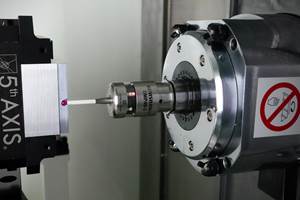Ballbars Will Keep Your CMM Honest
It is obvious that no one can afford to do a complete calibration of their CMM every day, but everyone can afford to do a seven minute interim check every day, or a least every Monday morning. This should be done using an artifact that encompasses the volume of the machine that is generally used.
Every time you use your coordinate measuring machine you are betting big bucks in a game that's stacked against you. Dr. Steven Phillips a researcher at National Institute of Standards and Technology (NIST) recently reported to the SME conference on CMM metrology that the U. S. Air Force found a high percentage of their own coordinate measuring machines did not meet specifications at the time of their yearly re-calibration.
When did the malfunctions occur? Who knows? The real question is how many good parts were rejected, or even worse, how many bad parts are up there flying around in high performance planes? The Air Force's solution to this problem was quick and to the point. They have initiated their own interim evaluation program and they are putting pressure on their contractors to do the same.
It is obvious that no one can afford to do a complete calibration of their CMM every day, but everyone can afford to do a seven minute interim check every day, or a least every Monday morning. This should be done using an artifact that encompasses the volume of the machine that is generally used.
There are many artifact designs available, but they mostly tend to be difficult to operate, expensive, or both. However, inexpensive, high quality ballbars have recently become available. These artifacts are by far the simplest and least expensive of the available devices. A modern ballbar can be purchased for under $300 and an accurate yearly calibration can be had for about $200. This calibration includes the sphericity of the balls and the actual size of the balls.
A ballbar consists of two very round spheres of exactly the same diameter securely attached to opposite ends of a long rigid bar with the ability to check the entire CMM system, one of the most complex inspection tools ever developed. That system includes the geometries of the entire metrology frame, the accuracies of the scales for at least the X, Y and Z axes, the measuring probe head, the contact tip, the computer and its software as well as the environment, including vibration, the temperature, the air supply and the electrical power.
This is in effect a spherical gage block. The use of the ballbar is easy. It is simply placed in a robust vertical stand and located in a number of different positions throughout the volume of the CMM. The distance between the centers of the two balls is fixed so that any variations in the measurements will indicate an error somewhere in the CMM system.
After the existence of a malfunction in the CMM system has been established, the question becomes, what's wrong? Here again, the ballbar can be of service. By positioning the ballbar in systematic patterns, the nature of the error can be isolated. There is an invaluable table of preferred ballbar positions in the ANSI standard B-89.1.12M for "Performance Evaluation of Coordinate Measuring Machines." A copy of this standard may be purchased from The American National Standards Institute.
If you don't already have an interim checking program it's time you changed the odds and stack the deck in your favor by initiating one.
Click here for more information about the author and Bal-Tec.
Related Content
Choosing the Correct Gage Type for Groove Inspection
Grooves play a critical functional role for seal rings and retainer rings, so good gaging practices are a must.
Read MoreHow To Calibrate Your Calipers
If you’re interested in calibrating your own digital, dial or Vernier calipers, here are some steps to take to make sure it goes off without a hitch.
Read MoreParts and Programs: Setup for Success
Tips for program and work setups that can simplify adjustments and troubleshooting.
Read MoreWhat Should Machinists Know About In-Machine Probing?
In-machine probing doesn’t reach the power of CMMs but can still be useful for pre- and mid-process control, as well as for “rough screening” of parts.
Read MoreRead Next
3 Mistakes That Cause CNC Programs to Fail
Despite enhancements to manufacturing technology, there are still issues today that can cause programs to fail. These failures can cause lost time, scrapped parts, damaged machines and even injured operators.
Read MoreThe Cut Scene: The Finer Details of Large-Format Machining
Small details and features can have an outsized impact on large parts, such as Barbco’s collapsible utility drill head.
Read More












.png;maxWidth=300;quality=90)











